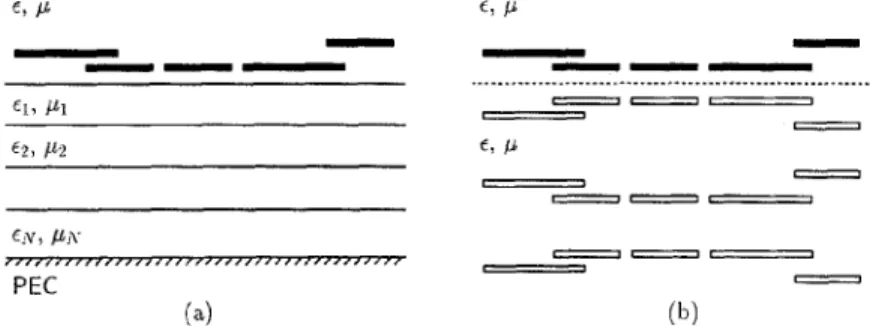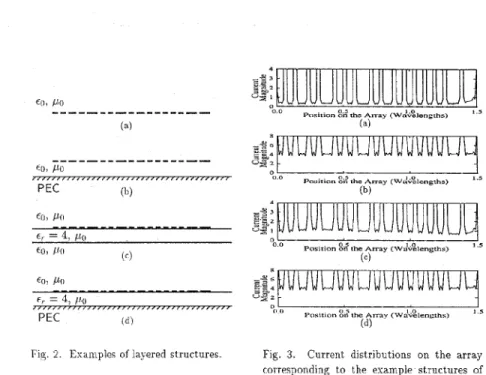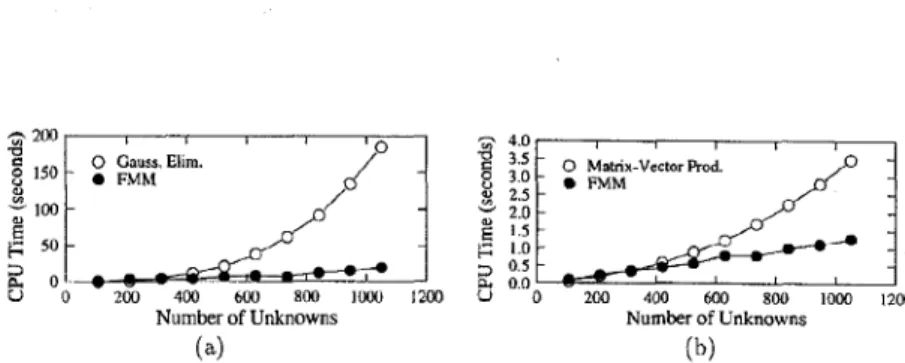Fast Multipole Method in Layered Media:
2-D Electromagnetic Scattering
Problemst
Levent Gurel” and
M ,I. Aksun
De@.
of
Electrical and Electronics Engineering
Bilkent
University
Bilkent, Ankara, Turkey
1
Introduction
The form~~lat,ion of l a y e r e d - m d n prohlems have traditionally been carried out in the spectral domain dne t o t h e availability of t h e Green’s functions in closed forms [1,2]. Recently, a series of techniques have been developed t.o obtain closed-form Green‘s func- tions (CFGFs) for layered media in the spatial domain [B,4]. T h e use of the CFGFs in a method-of-moments (MOh4) faormulation rednces the matrix-filling time by several orders of magnitude compared to the spectral-domain formulat,ion. However, it does not redncr the computational complexities of the matrix-filling time and the memory requirement, which are both O(Arz). Most importantly, despite the great savings in the matrix-filling time, the solution of the N x N dense matrix equation remains, which requires 0 ( A i 3 ) operations in a direct scheme or O ( N 2 ) operations per iteration i n an iterative scheme.
O n another front, several researchers are working to reduce the computational com- plexities and the memory requirements of the solution of integral equatious of electro- magnetics. For the iterative solutions of the integral equations based on the Ilelmholtz equation, the fast, multipole met~hod
(FMM).
mhich has O(Ar3/’) complexity per itera- tion, has recently attracted attention \&GI. T h e FhIM employs a l m m o n i c expansion of t h e closed-form Green’s function and has been limited to the homogeneous-medium problems so far. By obtaining a closed-form expression for t h e spatial-domain Green sfunction for an arbitrarily layered medium and by interpreting each tmm of she erpres- sion as a discrex complex image, we have been able to apply the FMM to t h e solution of la~ered-media,problems. Thus, we have obtained a fast solution technique for the iayered- media problems and extended the applicability of the FMM from ho~~~ogt.neous-rr~edium problems to layered-medium problems.
2
Fast Multipole
Method in
a
Layered Medium
T h e y-directed electric field a t point p = i x+
i s due to a y-directed line source with unit amplitude located at point p’ = hz’+
i z ’ is given byScience for Stahillty Programme and in p a r t by the Scirntific and Techn~cal Research C,ouncil of Turkey
tThis work was supportcd in part by NATO’s Scientific Affairs Diviaion in the framework of h e (TUBITAK) under contracts EEEAG-132 and EEEAG-163.
where
kTE
is the generalized reflection coefficient defined at the z = 0 plane due to an arbitrarily layered substrate below this plane.Using a robnst technique by Aksnn [4], Eq. (1) can be converted to a closed-form expression given by
whcre 1p - pLI = d(z - z‘)* $. ( z
+
z‘+
i c ~ , ) ~ and a, and an are complcx constants for n = 1 , 2,....
N I .The FkfM is based on the expansion of the Green’s function using the addition theorerris and no such expansions exist for the layered-media Green‘s rnnclions given in Eqs. (1) and (2). However, we can still employ the FhIM in the solution of a layered- medium problem if we interpret Eq. (2) as the linear superposition of the field due to a source a t p’ and the fields due to N I discrete complex images (DCIs) locatcd a t
pk L i z ‘
+
Z(-z’-
zan). T h e DCIs are located at complex coordinates and. therefore,we need to use addition theorems for wave functions with complex argnments.
Fig. 1. (a) Original problem in a layered medium. (b) Equivalent problem with DCIs i n a homogeneous medium.
With the DCI interpretation, an equivalent problem is set up in a homogeneous rncdium. In this equivalent problem, which is illustrated in Fig. l(b), N r image sources i n a homogeneous medium are defincd corrcsponding to each original source in the layered- medium problem [Fig. l(a)]. ‘rhus, if Ai testing functions are defined on the original conductors, N ( N 1
+
1) basis functions are defined on the original conductors and their images.The computation of the fields of N ( N ;
+
1) basis functions on the iV testing function5 is carried out using the FMM and repeated several times in an iterative scheme. Since Nr is a constant, this specific implementation of the FMM for layered-media problems has O(N”l’) computational complexity per iteration and O(N3I2) memory rcquircment as its homogeneo~~s-medi~rm counterpart.Fi5. 2. llsamylcs of layered structures Fig. 3. Current distributions on the array corresponding t.o the example structures of Fig. (2).
3
Computational Results
111 o r d c r 1 o delnoilslrale llle accuracy and the efficiency of the layered-media implemen- lation ol thc Y.U\l. a series of structures (as illustrated in Fig. 2), to which the mcthod can I>(: applied. 11;~vc been designed. Common to all these structures is an irregular, finite imd p h n a r array of strips, which ha.s an ovcrall extent of l.5X"3 as shown in Fig. 2(a). Tile same array is placed X o / l O O away from a conducting plane in Fig. 2(b) and the thickness of the dielectric slab in Figs. 2(cj and (d) is also X o / l O O . Figures 3(a)-(d)
presenl thc plots of the magnitude of the current on the arrays of Figs. 2(a)-(d), re- spectively, when illuminated by parallel-polarized plane waves incident a t 45'. These results are also checked against results obtained by employing direct solut,ion with G a m - sian elimination and iterative solution with ordinary matrix-vector multiplication. All three solution techniques are found to generate results that agree with each other for several digits, testifying to the accuracy of the iterative solution with layered-medium implementation of the FMRI.
Figure 4(a) compares the solution times of the layered-medium implementation of t h e
I?
" with the Gaussian elimination as the array geometry of Pig. 2(c) becomes larger. Similarly, Fig. 4(b) compares the per-iteration solution times of the layered-medium implementation of the FMM with the ordinary matrix-vector multiplication. As for t h e filling time, since only a sparse matrix of the near-field interactions is filled i n t h e FMM
as opposed to filling an
N
x N dense matrix in the direct solution, filling time of theFMM is always lower.
-
8 IM)50
U 0 2M) 4W 6M) 800 1 w O I2M) U 0 200 4M) 600 800 1000 1200
Number of Unknowns Number of Unknowns
( 4 (b)
Fig. 4. (a) Comparison of the solution times of the layered-medium implementation of the FMM and the Gaussian elimination. (b) Comparison of the per-iteration solution times of the layered-medium implementation of the FMM a a d the ordinary matrix-vector multiplication.
4
Conclusions
The applicability of t h e FMM has been extended to layered-media problems. As an
esamplc, we have demonstrated the solution of the scalar HelInholtz equation for t,he electromagnetic scattering from a two-dimensional planar array of horizontal strips on a lavered substrate.
References
[ I ] T. Itoh, “Spectral domain imrnittancc approach for dispersion characteristics of gmeralized transmission lines,” IEEE Trans. Microwave Theory Tech., vol. MTT-
28, pp. X - 7 3 6 , .July 19SO.
[2] W. C. Chew and L. Giirel, “Reflection and transmission operators for strips or disks embedded in homogeneous and layered media,“ IEEE Trms. !\ficrotunve Theory
T c c ~ . , V O ~ . RITT-36, pp. 14%-1497, NOV. 19SS.
[3]
Y.
L.
Chow, J. J . Yang, D. F. Fang, and G. E. Howard. “.A closed-form spatial Green’s function for the thick microstrip substrate,” lEEE Trans. Microwace T h e o r yTeci~., vol. MTT-39, pp. 5%-592, Mar. 1991.
[4] h.1. I. Aksun,
‘‘
A robust approach for t h e derivation of closed-form Green‘s func- tions,’‘ IEEE Trans. Microwave Theory Tech., in press.[5] V. Rokhlin, “Rapid solution of integral equations of scattering theory in two dimen- sions,” J . Comput. Phys., vol. 86, pp. 414-439, Feb. 1990
[6] C‘. C. Lu and W.


